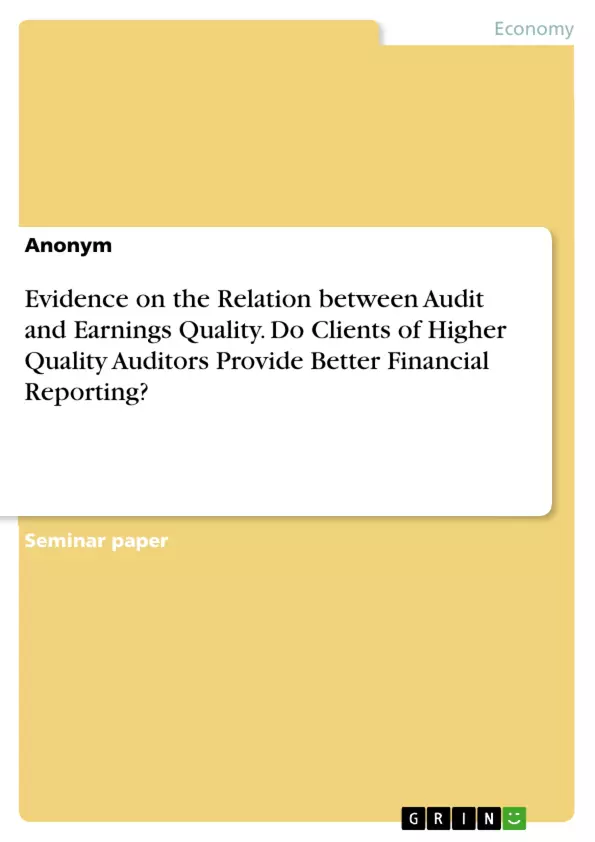This paper studies the relation between audit and earnings quality. It examines whether firms audited by a Big 4 member engage in higher earnings management activities as proxied by the magnitude of discretionary and absolute accruals, as well as an income smoothing measure. The author predicts that large auditors have higher competencies and incentives to deliver a higher quality audit. Therefore, their clients are expected to reveal less sophisticated earnings management and thus higher earnings quality. The results do not support this relation.
Since standardsetters have been concerned about managers’ use of discretion to manage earnings in their financial reports, an increasing amount of empirical research was conducted to address this issue, additionally to regulation. While independent auditors (aim to) assure that these statements are in accordance with legal compliance, the actual audit quality can be grasped as the contingency that the auditor exposes and discloses an anomaly in their clients’ financial reports. Whereas numerous audit scandals threaten the trustworthiness of well-known large auditors, there is various research revealing that Big N audited firms are supposed to disclose financial reports of higher quality.
Supplementing misguiding accrual accounting practices in this regard, this study also addresses another proxy for earnings management: income smoothing. Burgstahler and Dichev (1997) explain corporate income smoothing with the fact that managers avoid revealing earning decreases and losses to diminish costs arising from transactions with stakeholders. Similarly, Degeorge, Patel and Zeckhauser (1999) show that managers smooth earnings to meet analysts’ forecasts.
On the other hand there are various contrary studies. DeFond and Jimbalvo (1993) found that auditor-client disagreements resulting from earnings management, are more present in Big 4 audited firms. They explain this with the properties of the “common” Big 4 clients. For the reason of the ambiguous results, it is interesting to study the effects and compare them with prior evidence to answer the question whether Big 4 auditors deliver “higher” quality in terms of a “better” financial reporting. The terms are operationalized using a dis-cretionary accruals and income smoothing measure and analyzed for (non-)Big 4 audited UK-firms in the period 2005-2011.
Inhaltsverzeichnis (Table of Contents)
- Introduction
- Prior Research and Hypothesis Development
- Audit quality
- Earnings Quality
- Research Question and Design
- Audit Quality
- Discretionary Accruals
- Income Smoothing
- Sample and Data
- Sample Composition
- Descriptive Statistics
- Correlations
- Distributional Properties
- Linearity and Normality
- Heteroskedasticity
- Empirical Results
- Discretionary Accruals
- Income Smoothing
- Discussion
- Conclusion
Zielsetzung und Themenschwerpunkte (Objectives and Key Themes)
This paper investigates the connection between audit quality and earnings quality, specifically examining whether firms audited by Big 4 accounting firms engage in more earnings management activities. The research aims to determine if higher quality audits lead to improved financial reporting.
- The relationship between audit quality and earnings management
- The role of Big 4 auditors in promoting financial reporting quality
- Earnings management strategies employed by companies
- The impact of audit quality on stakeholder trust and decision-making
- Empirical analysis of discretionary accruals and income smoothing
Zusammenfassung der Kapitel (Chapter Summaries)
- Introduction: This chapter provides a broad overview of the research topic, highlighting the significance of audit quality and earnings management in financial reporting. It emphasizes the importance of examining the relationship between these factors and introduces the research question. The chapter also provides a brief overview of the study's methodology and structure.
- Prior Research and Hypothesis Development: This chapter reviews existing literature on audit quality and earnings quality, exploring various perspectives on the connection between these concepts. The chapter analyzes the theoretical frameworks and empirical findings related to both audit quality and earnings management, providing a foundation for hypothesis development.
- Research Question and Design: This chapter details the research question and specifies the study's design. It elaborates on the measures used to assess audit quality and earnings quality, outlining the specific variables and proxies employed in the analysis. The chapter explains the research model used to examine the relationship between audit quality and earnings management.
- Sample and Data: This chapter describes the sample of firms included in the study and outlines the data collection process. It provides information on the characteristics of the sampled companies and the time period covered by the data. The chapter presents descriptive statistics summarizing the data and examines potential relationships between variables.
- Empirical Results: This chapter presents the results of the empirical analysis, examining the relationship between audit quality and earnings quality. The chapter discusses the findings regarding the use of discretionary accruals and income smoothing as proxies for earnings management. It also examines the role of Big 4 auditors in promoting financial reporting quality.
- Discussion: This chapter analyzes the findings from the empirical results, discussing the implications for the relationship between audit quality and earnings quality. It provides insights into the factors influencing earnings management and the role of Big 4 auditors in promoting transparency and accountability in financial reporting. The chapter also highlights any limitations of the study and discusses potential areas for future research.
Schlüsselwörter (Keywords)
This research focuses on the relationship between audit quality and earnings quality. Key concepts include earnings management, discretionary accruals, income smoothing, Big 4 auditors, financial reporting, and stakeholder trust.
- Citar trabajo
- Anonym (Autor), 2017, Evidence on the Relation between Audit and Earnings Quality. Do Clients of Higher Quality Auditors Provide Better Financial Reporting?, Múnich, GRIN Verlag, https://www.grin.com/document/368367



